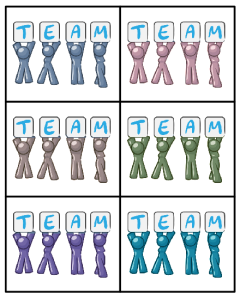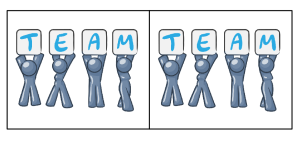The Care And Training of Your PET TEAM
The Care And Training of Your PET TEAM®
CONGRATULATIONS!
You are now the owner of a genuine, pedigreed PET TEAM®
IMPORTANT: DO NOT REMOVE YOUR PET TEAM® FROM ITS SHIPPING CONTAINER BEFORE READING ITEM 1 IN THIS BOOKLET
© 1975
Team Bottom® Productions
Item 1
Your new team is a very sensitive pet and may be slightly traumatized from all the handling and shipping required in bringing you all together. While you may look in on your new pet from time to time, it is essential that you leave your team in its shipping container for a few days. It is advised that you set the container in an area of your office that is to become your PET TEAM’s “special place”. Some PET TEAM owners have found that the rasp of an old dot-matrix printer operating near the shipping container has a soothing effect; especially at night. It takes most PET TEAMS exactly two weeks days to acclimate themselves to their new surroundings. After ten working days have passed you may remove the team from its shipping container and begin enjoying your new pet.
NOTE
If, when you remove the team from its shipping container, its members appears to be excited, place them on some old newspapers. The team will know what the paper is for and will require no further instruction. They will remain on the paper until you remove them.
Your PET TEAM And You
Your PET TEAM will be a devoted friend and companion for many years to come. Teams enjoy a rather long life span so the two of you will never have to part – at least not on your PET TEAM’s account. Once you have transcended the awkward training stage your team will mature into a faithful, obedient, loving pet with but one purpose in life – to be at your side when you want, and to go lie down when you don’t. A PET TEAM is perfect for people who hate animals, are allergic to animals, or who are not allowed to keep animals. When you own a PET TEAM you never have problems with leash law violations, you’ll never have to clean up nasty messes, and your pet will never keep you and the management awake at night. PET TEAMS are welcome everywhere.
Know Your Team
Your PET TEAM didn’t come out of any old Team factory, you know. There is nothing common about genuine, pedigreed PET TEAMS. They descend from a long line of famous teams. Their ancestors can be found amongst the workers of the pyramids; the slaves of Ancient Rome; and the plantations of the Caribbean and Southern States. PET TEAMS descend in one unbroken line that can be traced back to the beginning of time and even farther. PET TEAMS are found with the aid of a specially-trained Team Hound. They are then examined for congenital defects prior to intelligence evaluations. Only teams that have demonstrated a strong capacity for learning and obedience are allowed to wear the name PET TEAM. Upon passing initial tests they are prepared for shipping, packed into their cartons and sent throughout the world to anxious owners.
Your team is a one of a kind.
There Are Hundreds Of Breeds Of Teams
Of the hundreds of breeds of teams known to Man, only a few show the necessary aptitude required of a PET TEAM. The more important traits associated with genuine PET TEAMS are gentle disposition, eagerness to please, and a profound sense of responsibility.
Initial Training
Nobody, but nobody likes a surly, misbehaving team. Therefore, it is most important that you begin training immediately. Your PET TEAM should be made to know who is the boss, and that you will demand certain good manners and impeccable behavior if you are to all have a happy, well adjusted relationship.

A few of the more popular breeds.
Limit your training sessions to fifteen minutes, twice each day. One half-hour session is not recommended as a team’s attention span is rather short. Remember; a bored team is an unhappy team. The first section of this training manual will address itself to simple obedience—COME, SIT, STAY, etc. Amusing tricks will be covered in Section Two. No special equipment is required in training your new PET TEAM. Amazingly, a team is one of the few pets that will respond to training without the aid of leash or choke chain. First, select a special training area. Use the same area for all training sessions until your team is showing good progress.
SECTION ONE Simple obedience
Come
It is essential that your PET TEAM learn this command. A team that doesn’t come when it’s called will cause its owner endless embarrassment.

Command gently but firmly.
It is assumed that you have given your PET TEAM a name by now. If you have not, do so before proceeding with obedience training. To teach the command COME, place your team on the floor or carpet and take a few steps backward. Next, bending over from the waist, place your hands upon your knees and face your team. Now, with firm authority, say, COME CODESTARS. (If you have not named your team CodeStars you may wish to say something else.) Repeat the command, COME CODESTARS. Assuming your team is normal it will probably not respond. Start again. Bending over from the waist, face your team, clap your hands, and let your face light up as you say, COME CODESTARS, C’MON GUYS, OVER HERE, and stuff like that. Now, start walking slowly toward your team. Incredibly, as you walk toward your team you will notice that it actually is coming closer. This means your PET TEAM is learning the command, COME. Praise your team and give them pats of approval.
NOTE
Many PET TEAMS have tremendous difficulty learning the command, COME. PET TEAM owners have complained that their teams were stupid, dimwitted and slow because of it. Well, this is ridiculous. To be sure, training a team to come when it’s called requires extraordinary patience. It is a rare team indeed that will leap into its master’s arms the first time it hears the command. And, while it takes quite a while to train a team to come when its name is called, the problem lies not in the team’s inability to learn commands; the problem lies in the fact that a team has an extremely hard time learning its name. Be patient, calm and gentle.
Stay
The next command to teach your team is STAY. It is very important that your PET TEAM learn this command as it is disconcerting to have a team that will wander around while you are in a meeting or having a massage. Return to your training area and set your team upon the floor or ground. Look at your team intently, like you really mean business, and give the command, STAY. Surprisingly, most teams have no difficulty learning this command and respond quite obediently the first time they hear it. Repeat the command, STAY, and slowly back away from your team. If your team should move, and this is highly unlikely, shout the command while gesturing dramatically with the palm of your outstretched hand. In no time at all your PET TEAM will be responding to this obedience command each and every time. With further patience you can train your team to STAY by using only the hand signal.
Sit
This is not a difficult command to teach a PET TEAM as most teams spend the bulk of their time sitting around anyway. However, a refresher course is certainly in order since you will want your team to sit when you want them to, not when they want to. Place your team in its training area and give the command, SIT. Many teams will attempt to deceive you by lying down, thinking that you won’t know the difference. This should not be encouraged If you say, SIT, then your team PET TEAM should sit and that’s all there is to it. Here is a simple method to ensure your PET TEAM always obeys your commands: Repeat the order, SIT, and slowly walk away from your team. Now, hide in another office and, from time to time, peek in on your team to make sure they haven’t moved. If they lie down, when they should be sitting, storm into the room and shout, BAD TEAM, BAD TEAM Your PET TEAM will know it has displeased you and will return to the sitting position. It will also know who’s the boss.
Once your PET TEAM learns the command, SIT, add the command, STAY. Your team will now remain sitting until further notice.
Down
It would be cruel to leave your team in the sitting position forever. Therefore, it is necessary that you teach it the command, DOWN. After sitting for a long period of time your team will appreciate the chance to relax. It is also nice, when you have e.g. visiting clients, to own a PET TEAM that will lie, unobtrusively and lovingly, at your feet. Teaching the command, DOWN, is best accomplished in conjunction with the command, SIT. After your PET team has been in the sitting position for a while, give it the command, DOWN. If you’ve made a big fuss about your team sitting properly they may be reluctant to move. Place your foot upon your team and push each on in turn firmly into the carpet or dirt. It won’t take long before your team understands what you want them to do. DOWN is another of the training commands that most teams respond to with a minimum of teaching.
It is in a PET TEAM’s nature that it learns to get down so easily. Praise your team and give them all a gentle, reassuring hug.
Stand
You’re a little confused if you think a PET TEAM can be taught to STAND. There is no f-e-e-t in t-e-a-m.
Heel
It is extremely unusual to see a team strolling around unaccompanied – there’s a very good reason for this. Most PET TEAM owners have had the patience and good judgment to teach the command, HEEL
To teach your PET TEAM to HEEL, simply follow these easy steps. First, place your PET TEAM on the floor or carpet directly behind your right heel. Next, give the command, HEEL, and stand absolutely still. Slowly, without moving your feet, turn and look down at your team. You will be both pleased and amazed to see they are still there, right where you want them be, directly behind your right heel. Your PET TEAM has learned the command. Praise your team.
SECTION TWO Amusing Tricks
Few pets are more anxious to please their masters than are PET TEAMS. It is surprisingly easy to teach your team cute tricks that will entertain you and your peers for hours.
Roll Over
Your PET TEAM will learn this trick the very first time you give them a lesson. That statement may be hard to believe but it is, nevertheless, quite true. The best place to teach your PET TEAM to ROLL OVER is on a relatively steep slope, or failing that, your office. Place your team on the floor at the top of the slope and, still holding on to them, give the command, ROLL OVER. Now, let go of your team. It’s that simple!
Your team will roll end-over-end and will not stop until they tire of the game. PET TEAMS usually get tired of the game when they reach the bottom of the slope. Follow your team to the bottom of the slope and praise them profusely. This praise will make your PET TEAM very happy and they will repeat the trick as soon as you return them to the top of the slope. You will tire of this trick long before your PET TEAM does.
Play Dead
Your PET TEAM will take to this trick like a duck takes to water. It is one of the most entertaining tricks a team can learn, and a trick that is sure to get many affectionate laughs and approving glances from you and your peers. Take your PET TEAM to its training area and, when you have their undivided attention, give the command, PLAY DEAD. If your team is like most teams it will not have to be told more than once. Immediately, it will go completely limp as though shot through the head, and will remain in this posture until you give a different command. Teams enjoy this trick so much that often, when you’re not even looking, they’ll actually practice it on their own. It’s not unusual to walk into a room and see a PET TEAM playing dead.
Shake Hands
Don’t be ridiculous. You can’t teach a team to shake hands.
Feeding
PET TEAMS really enjoy their food and drink, but, as nearly everyone knows, they are atrocious nutritionists. Therefore, teaching your team to eat well and drink plenty of water is very important. To do this, first find e.g. a pizzeria or company canteen. DO NOT ATTEMPT THIS TRICK IN AN EXPENSIVE RESTAURANT. Hold your team firmly in hand, give the command, EAT, and stand well back. More often than not, and depending upon your nimbleness, your PET TEAM will eat happily until they’re stuffed. If your Team does not make it happily through all the items of the menu, it may be terminally ill. If that happens, you’ll be needing a new one. Too bad.
Fetch
To teach your PET TEAM to FETCH, declare a challenging BHAG or stretch goal. Next, send your PET TEAM after it. Rarely, if ever, will your PET TEAM return with the goal completed, but that’s the way it goes.
Attack Training
A PET TEAM is a loyal, devoted pet that can easily be trained to protect you and your company. Woe be to the competitor or other teams who venture into the offices guarded by a PET TEAM – or the client or supplier who attempts to cross a PET TEAM’s master. There are two basic attack methods to teach your PET TEAM.
1) Long Distance Attacks
2) Close Range Attacks
Long Distance Attacks
In those instances when your adversary is at a distance (such as when another manager finagles your budget and keeps laughing about it from their own offices), your PET TEAM will respond to the challenge instantly and effectively in assuring that it never happens again. First, clear the rage form your brow. Next, pick up your PET TEAM. Shout the command, ATTACK , and send your team to the swine’s office with all speed. This method of protection is sure-fire and results are guaranteed, although you may want to practice your plausible denial abilities before attempting this manoeuvre.
Close Range Attacks
If you are threatened at close range always use the Close Range Attack Method; it is the ultimate form of personal protection. The element of surprise enters into this attack method, thereby making it doubly effective.
When the adversary approaches within arm’s length and demands all your staff, budgets and other valuables, follow these easy steps: Reach for your laptop or mobile phone as though you were going to comply with your adversary’s demands. Summon your PET TEAM. Shout the command, ATTACK. And together bash your adversary’s head in. PET TEAMS really seem to enjoy this exercise and, in most cases, come away from the attack little the worse for wear.
NOTE
Owners of Attack Trained PET TEAMS have a responsibility to society to use their dangerous pets for protection only, and not for instigating trouble of any kind.
Health Care
A healthy team is a happy team, everybody knows that It is, therefore, extremely important that you learn health care and emergency first aid techniques as they regard your PET TEAM. PET TEAMS are, to be sure, quite hardy. However, an occasional accident or disease may befall your team and you should know how to care for it. Also, visits to the company nurse’s station can be very time-consuming. Here are some of the more serious problems that can befall a PET TEAM, along with instructions for their cures.

A team in perfect health. A team in obvious distress.
Rock Bottom
If your PET TEAM appears nervous and fidgety, it’s a better than even chance it’s suffering from dreaded Rock Bottom. No other disease is as debilitating to PET TEAM as Rock Bottom. The first symptoms are manifested in an almost unbelievable forgetfulness. Your PET TEAM will not remember a single command or trick. All the hours of training will be forgotten. It will be the saddest day of your life. From simple loss of memory it gets worse. So bad in fact, that we won’t go into it here. Suffice to say that, should your PET TEAM contract Rock Bottom, get a new PET TEAM immediately. There is no known cure.
Teams in the wild
Perhaps you have seen a particular team in the wild and thought it would make a nice pet. DO NOT APPROACH THAT TEAM. This is to be discouraged. Wild teams can give you nothing but headaches. They can be surly, vicious, and unpredictable. They are nearly impossible to domesticate and show practically no learning abilities whatsoever. There’s an old saying in team circles, “Once a wild team, always a wild team.” A genuine, pedigreed PET TEAM will make a much more suitable companion.
In Closing
As the owner of a PET TEAM you have assumed a responsibility to love and care for this new addition to your family. If your team should misbehave, be patient. If it should cause you problems, be forgiving. Under no circumstances should you turn your PET TEAM loose. The world is already overcrowded with discarded, unwanted teams, and millions must be destroyed each year. These poor, unfortunate teams meet brutal ends in death marches, financial and government organisations, or as land fill. Don’t allow your PET TEAM to meet an untimely demise at the bottom of an obscure pile of ordure. Remember; if you take care of your PET TEAM, your PET TEAM will take care of you.
© 1975
Team Bottom® Productions



This may be the best blog you have written in a long time, thank you